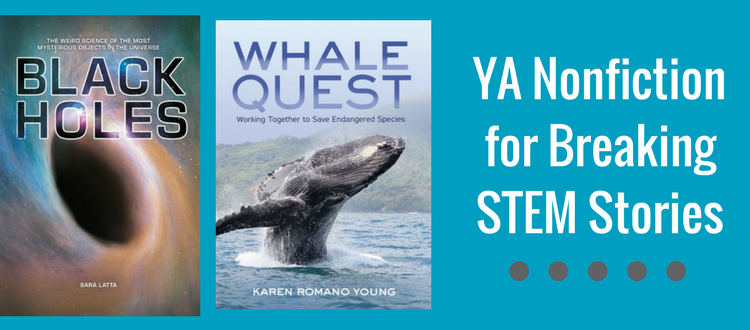Black Holes and Whales: YA Nonfiction on Newsworthy STEM Topics

Our teen nonfiction imprint, Twenty-First Century Books, has some dynamic new Fall 2017 YA nonfiction titles to pair with breaking STEM stories.
Black holes and the Nobel Prize
For starters, the 2017 Nobel Prize in Physics was announced on Tuesday. It was awarded to Rainer Weiss, a professor at the Massachusetts Institute of Technology, and to Kip Thorne and Barry Barish, both of the California Institute of Technology. In 2015, with laser interferometer gravitational-wave observatory technology (LIGO), they discovered gravitational waves. (Albert Einstein had predicted them in the early twentieth century.) These gravitational waves are produced when black holes collide.
Chapter 3 in Black Holes: The Weird Science of the Most Mysterious Objects in the Universe by science writer Sara Latta is devoted to the LIGO research and discovery! This is definitely a TFCB STEM title for your YA collection.
Whales in the news
Additionally, the lead story in this week’s Science Times section (New York Times, 3 October 2017) focuses on whale populations and the perils they face in warming ocean waters. The article centers on humpbacks and North Atlantic right whales in the Atlantic Ocean. Warming there leads the animals beyond their normal ranges to find food. This often shifts them into shipping lanes where they sometimes take direct hits and eventually die from their injuries.
Hope and help lie in ongoing studies and protection measures by committed researchers, citizen scientists, governments, shipping companies, and conservation groups alike. Scientists carefully observe whale migration, mating, and feeding patterns. They share information and ideas through a range of venues, apps, and social media such as Flickr, Facebook, and other sites. Public awareness of the threats to whales is growing and change is happening.
TFCB’s Whale Quest: Working Together to Save Endangered Species by Karen Romano Young is the YA whale book to add to your collection. Meet some of the cetologists and citizens who are studying whales and their marine lives. Learn how this work can help protect endangered whales such as the Cook Inlet beluga and the Southern Resident killer whales. Plus, meet whales of literature, film, and pop culture; learn about the whale life cycle; about whales in captivity; and about whale sanctuaries in the world’s oceans.
And, readers will learn how average citizens can whales. Like fourteen-year-old Maris Sidenstecker, who founded Save the Whales in 1977, we can make a difference.
Learn more about this season’s new nonfiction for teens here.


Comments